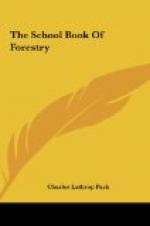For many years, the United States Forest Service and State Forestry Departments have been keeping a record of forest fires and their causes. Studies have been made of the length and character of each fire season. Information has been gathered concerning the parts of the forest where lightning is most likely to strike or where campfires are likely to be left by tourists. The spots or zones of greatest fire danger are located in this way and more forest guards are placed in these areas during the dangerous fire season. Careful surveys of this kind are aiding greatly in reducing the number of forest fires.
In trying to get all possible information about future weather conditions, the Forestry Departments cooeperate with the United States Weather Bureau. When the experts predict that long periods of dry weather or dangerous storms are approaching, the forest rangers are especially watchful, as during such times, the menace to the woods is greatest. The rangers also have big fire maps which they hang in their cabins. These maps show the location of dangerous fire areas, roads, trails, lookout-posts, cities, towns and ranches, sawmills, logging camps, telephone lines, fire tool boxes and other data of value to fire fighters. All this information is so arranged as to be readily available in time of need. It shows where emergency fire fighters, tools and food supplies can be secured, and how best to attack a fire in any certain district. A detailed plan for fighting forest fires is also prepared and kept on file at every ranger station.
The following are six rules which, if put in practice, will help prevent outbreaks of fires:
1. Matches.—Be sure your match is out. Break it in two before you throw it away.
2. Tobacco.—Throw pipe ashes and cigar or cigarette stubs in the dust of the road and stamp or pinch out the fire before leaving them. Don’t throw them into the brush, leaves or needles.
3. Making camp.—Build a small campfire. Build it in the open, not against a tree or log, or near brush. Scrape away the trash from all around it.
4. Leaving camp.—Never leave a campfire, even for a short time, without quenching it with water or earth. Be sure it is out.
5. Bonfires.—Never build bonfires in windy weather or where there is the slightest danger of their escaping from control. Don’t make them larger than you need.
6. Fighting fires.—If you find a fire, try to put it out. If you can’t, get word of it to the nearest United States forest ranger or State fire warden at once.
Remember “minutes count” in reporting forest fires.
CHAPTER VII
INSECTS AND DISEASES THAT DESTROY FORESTS




